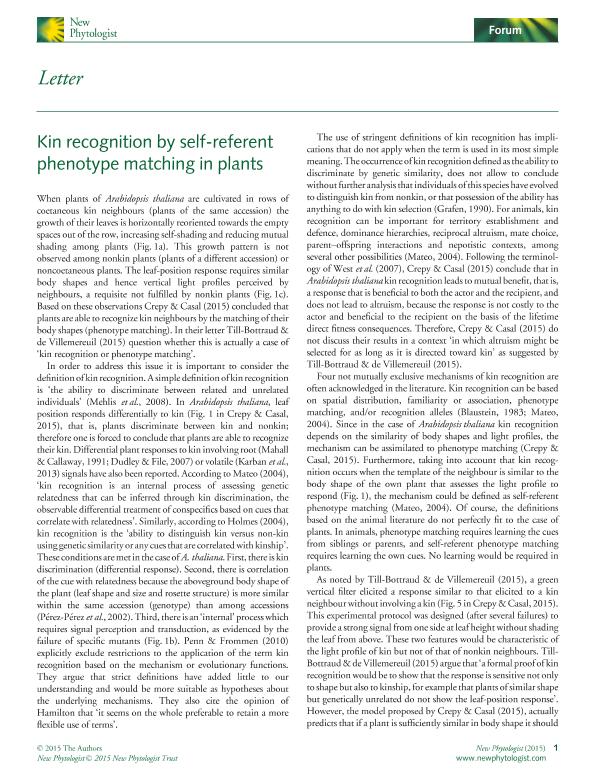Mostrar el registro sencillo del ítem
dc.contributor.author
Crepy, Maria Andrea

dc.contributor.author
Casal, Jorge José

dc.date.available
2018-05-02T15:20:30Z
dc.date.issued
2016-01
dc.identifier.citation
Crepy, Maria Andrea; Casal, Jorge José; Kin recognition by self-referent phenotype matching in plants; Wiley Blackwell Publishing, Inc; New Phytologist; 209; 1; 1-2016; 15-16
dc.identifier.issn
0028-646X
dc.identifier.uri
http://hdl.handle.net/11336/43842
dc.description.abstract
When plants of Arabidopsis thaliana are cultivated in rows ofcoetaneous kin neighbours (plants of the same accession) thegrowth of their leaves is horizontally reoriented towards the emptyspaces out of the row, increasing self-shading and reducing mutualshading among plants (Fig. 1a). This growth pattern is notobserved among nonkin plants (plants of a different accession) ornoncoetaneous plants. The leaf-position response requires similarbody shapes and hence vertical light profiles perceived byneighbours, a requisite not fulfilled by nonkin plants (Fig. 1c).Based on these observations Crepy & Casal (2015) concluded thatplants are able to recognize kin neighbours by the matching of theirbody shapes (phenotype matching). In their letter Till-Bottraud&de Villemereuil (2015) question whether this is actually a case of?kin recognition or phenotype matching?.
dc.format
application/pdf
dc.language.iso
eng
dc.publisher
Wiley Blackwell Publishing, Inc

dc.rights
info:eu-repo/semantics/openAccess
dc.rights.uri
https://creativecommons.org/licenses/by-nc-sa/2.5/ar/
dc.subject
Kin Recognition
dc.subject
Self-Referent Matching
dc.subject
Neighbour Plant
dc.subject
Light Signals
dc.subject.classification
Otras Ciencias Biológicas

dc.subject.classification
Ciencias Biológicas

dc.subject.classification
CIENCIAS NATURALES Y EXACTAS

dc.title
Kin recognition by self-referent phenotype matching in plants
dc.type
info:eu-repo/semantics/article
dc.type
info:ar-repo/semantics/artículo
dc.type
info:eu-repo/semantics/publishedVersion
dc.date.updated
2018-04-27T18:54:54Z
dc.journal.volume
209
dc.journal.number
1
dc.journal.pagination
15-16
dc.journal.pais
Reino Unido

dc.journal.ciudad
Londres
dc.description.fil
Fil: Crepy, Maria Andrea. Consejo Nacional de Investigaciones Científicas y Técnicas. Oficina de Coordinación Administrativa Parque Centenario. Instituto de Investigaciones Fisiológicas y Ecológicas Vinculadas a la Agricultura. Universidad de Buenos Aires. Facultad de Agronomía. Instituto de Investigaciones Fisiológicas y Ecológicas Vinculadas a la Agricultura; Argentina. Instituto Nacional de Tecnología Agropecuaria; Argentina
dc.description.fil
Fil: Casal, Jorge José. Consejo Nacional de Investigaciones Científicas y Técnicas. Oficina de Coordinación Administrativa Parque Centenario. Instituto de Investigaciones Fisiológicas y Ecológicas Vinculadas a la Agricultura. Universidad de Buenos Aires. Facultad de Agronomía. Instituto de Investigaciones Fisiológicas y Ecológicas Vinculadas a la Agricultura; Argentina. Fundación Instituto Leloir; Argentina
dc.journal.title
New Phytologist

dc.relation.alternativeid
info:eu-repo/semantics/altIdentifier/url/https://nph.onlinelibrary.wiley.com/doi/abs/10.1111/nph.13638
dc.relation.alternativeid
info:eu-repo/semantics/altIdentifier/doi/http://dx.doi.org/10.1111/nph.13638
Archivos asociados
